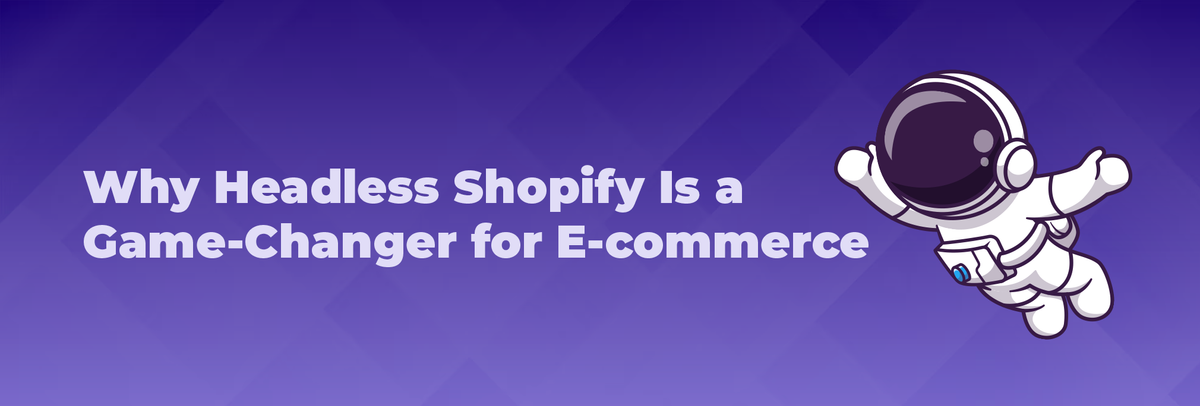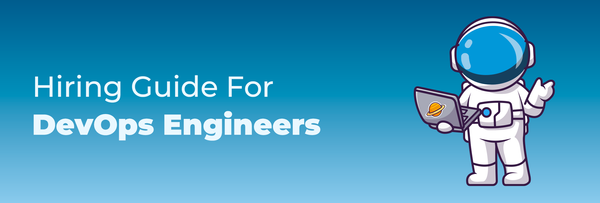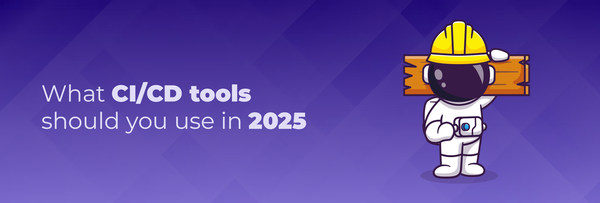Why Headless Shopify Is a Game-Changer for E-commerce

E-commerce is rapidly evolving, with new technologies transforming the way businesses engage with customers.
One such breakthrough is headless commerce, a flexible approach that decouples the front and back ends of online stores.
Unlike traditional models, headless commerce allows for greater customization and faster performance.
This shift, particularly with Shopify headless, is gaining traction as businesses seek more tailored and efficient solutions.
In this blog, we'll delve into the differences between headless commerce vs traditional commerce and explore how Shopify headless is revolutionizing the e-commerce landscape, offering unprecedented flexibility and innovation for brands.
What is Headless Commerce?
Headless commerce is an innovative e-commerce model that separates the front-end presentation layer from the back-end functionality, providing exceptional flexibility in content delivery across various platforms such as websites, mobile apps, kiosks, and IoT devices.
This architecture is increasingly popular, with 63% of retail companies planning to transition to headless commerce platforms in 2024, and over 20% already adopting them.
Brands favor this approach for its ability to facilitate unique and creative storefront experiences that are often constrained in traditional monolithic systems.
Developers are drawn to headless commerce for the control it offers, allowing them to build custom solutions using a composable tech stack with best-of-breed commerce tools.
By going headless, businesses can develop multiple front-end experiences for various customer touchpoints—web, mobile, voice, and point-of-sale (POS)—all interacting with a single backend through an API layer.
This capability supports a truly omnichannel strategy and enables rapid international expansion.
On the backend, headless commerce provides the advantage of using loosely coupled, specialized services to meet complex operational needs.
Its composable nature allows for easy integration and swapping of CMS, CRM, or DXP systems, avoiding vendor lock-in and accommodating changing business requirements.
Understanding Headless Shopify: Benefits, Architecture, and Comparison with Traditional E-commerce
Headless Shopify allows merchants to separate Shopify’s e-commerce engine from their store’s front end.
Unlike traditional Shopify setups, which integrate the front and backend into a monolithic system, headless Shopify utilizes APIs to connect these two components as distinct platforms.
This decoupling enables a Shopify backend to interface with various frontends, such as websites, mobile applications, kiosks, conversational interfaces, and smart mirrors.
With headless Shopify, you leverage Shopify’s core e-commerce functionalities—like payment processing, inventory management, and product handling—while maintaining full control over the design and functionality of your digital touchpoints.
Headless commerce tools and a headless tech stack empower you to create a customized, engaging user interface for each front-end experience.
Shopify supports this headless approach through its Storefront API, allowing developers to build unique frontends with technologies like React or Next.js.
This setup contrasts with traditional Shopify, which bundles frontend and backend functionalities together in a monolithic package.
Headless Shopify provides greater flexibility and performance, avoiding the bloat associated with additional third-party apps and plugins, which can slow down traditional setups.
While traditional Shopify offers limited customization within its built-in themes, headless Shopify delivers unparalleled freedom to choose any front-end technology, providing a superior user experience.
Furthermore, enterprise headless commerce solutions benefit from this architecture’s ability to serve multiple frontends simultaneously and integrate new ones as needed, a significant advantage over the single-frontend limitation of traditional systems.
Headless Shopify examples and headless website examples demonstrate the versatility and power of this approach, illustrating how businesses can achieve exceptional performance and adaptability with a headless e-commerce Shopify solution.
The 6 Key Benefits of Headless Commerce
Understanding headless commerce reveals that the value lies not in the mere absence of a front-end but in the flexibility it offers.
Headless commerce enables a variety of omnichannel implementations without being restricted by specific tools or outdated systems.
- Omnichannel Experiences
Headless commerce facilitates the creation of innovative digital channels, enriching the customer journey.
It supports interactive shopping experiences through AR/VR and social media without altering the back-end systems.
Brands can also leverage the API layer to integrate new customer touchpoints, such as transforming Instagram accounts into mobile storefronts with features like Shop Now.
- Development Freedom
One of the standout advantages of headless commerce is the freedom it grants developers.
Teams can use their preferred programming languages and technologies to make updates and add features, enabling greater flexibility and customization.
- Robust APIs
The robust APIs provided by headless commerce allow developers to manipulate data, integrate new technologies, and deliver an exceptional shopping experience.
This flexibility is crucial for creating tailored solutions that enhance user engagement.
- Agility and Speed-to-Market
By decoupling the front end/ from the back end, development teams can work simultaneously on both components, leading to quicker development cycles and more efficient workflows.
This separation also allows for the repurposing of content across various channels—such as mobile apps, smartwatches, and voice apps—making the system adaptable to future needs.
- Best-of-Breed Integrations
Enterprise retailers often require diverse solutions to meet unique delivery needs.
Headless commerce supports flexible and extensible data models and provides robust APIs for seamless integration with third-party technologies like chatbots, voice assistants, and AI.
This results in a more personalized customer experience and better brand alignment.
- Scalability and Performance
Headless commerce systems are designed to scale effectively, allowing businesses to make front-end changes without impacting back-end functionality.
This ensures that e-commerce sites can grow and adapt without disrupting core operations.
Top 3 Examples of Headless Shopify Architecture
- Allbirds
Renowned for their ultra-comfortable shoes, Allbirds swiftly made a mark in the retail industry, reaching a valuation of $1 billion within two years.
From the outset, they used Shopify to power their online store.
When their website traffic surged, they opted for a headless tech stack to enhance user experience without compromising site performance.
This approach allowed them to maintain flexibility and speed while avoiding complex, costly back-end systems.
Allbirds utilizes the React-based Hydrogen Shopify framework for custom storefronts, showcasing practical headless Shopify examples.
They leverage Shopify’s robust stack to build efficient headless Shopify storefronts.
- Victoria Beckham Beauty
Victoria Beckham Beauty’s philosophy—that “beauty should complement and empower the dynamic life you lead”—applies to their e-commerce strategy as well.
Rather than redesigning their entire system, they employed headless Shopify to customize every aspect of the shopping experience, from product selection to payment, ensuring a personalized and seamless customer journey.
The site is powered by Contentful, a headless content management system, provides a flexible content model and features like production content APIs.
This is a prime example of enterprise headless commerce.
- Inkbox
Inkbox, a Canadian company specializing in temporary tattoos, needed a scalable solution to handle its expanding customer base and online platform.
They transitioned to Shopify and implemented a headless e-commerce Shopify setup to manage high order volumes efficiently and improve conversion rates.
This move significantly contributed to their status as one of the fastest-growing tattoo brands worldwide.
Inkbox’s headless website example combines a custom front-end with Shopify’s backend functionality, demonstrating the effective use of headless commerce tools for an enhanced e-commerce experience.
3 Key Challenges and Considerations in Adopting Headless Shopify
- Complex Integration Process
Adopting headless Shopify presents the challenge of integrating multiple systems, such as Content Management Systems (CMS), Customer Relationship Management (CRM) tools, and other third-party applications.
This integration requires meticulous planning and execution to ensure seamless connectivity. Managing these various platforms can introduce complexities that might affect data consistency and overall user experience.
Additionally, maintaining optimal performance across different systems is crucial, as poor performance can lead to increased bounce rates and a diminished user experience.
- Cost Implications
Implementing a headless commerce system can involve significant financial outlay.
The initial setup, ongoing maintenance, and scaling of such systems require substantial investments in development and integration.
The need for a specialized team skilled in front-end and back-end development, as well as API management, adds further to the costs.
Businesses must carefully evaluate these expenses against the potential benefits, considering that the complexity of the integrations and operational scale could lead to higher expenditures.
- Choosing the Right Technology Stack
Selecting the appropriate headless tech stack is a critical consideration in headless commerce.
Businesses need to ensure that the chosen technology stack aligns with their specific needs and integrates effectively with their existing systems.
The right stack can significantly impact the flexibility, scalability, and overall performance of the e-commerce setup.
Ensuring compatibility between various technologies and making informed choices about headless commerce tools are essential for a successful implementation.
How to Get Started with Headless Shopify: Partner with Teamo for Expert Guidance
Embarking on a headless Shopify journey can seem daunting, but with the right approach and support, it becomes an exciting opportunity for growth.
Here's how you can get started and maximize your success:
- Define Your Requirements
Begin by outlining your business needs and objectives for adopting a headless Shopify solution.
Consider aspects such as desired customer experiences, necessary integrations, and scalability requirements.
This will help in selecting the right technology stack and planning your implementation strategy.
- Choose the Right Technology Stack
Selecting a suitable headless tech stack is crucial.
Opt for technologies that align with your business goals and integrate well with your existing systems.
Evaluate various headless commerce tools and ensure they meet your specific requirements for performance, flexibility, and compatibility.
- Partner with Expert Developers
To ensure a smooth transition to headless Shopify, partnering with a team of skilled developers is essential.
Teamo offers a powerful solution to accelerate your headless commerce journey.
Our 10x Talent provides top-tier, pre-screened software developers from emerging markets who seamlessly integrate as remote powerhouses within your development team.
- Seamless Integration: Our developers are adept at integrating various systems to create a cohesive headless commerce setup.
- Fast and Affordable: We offer efficient and cost-effective solutions tailored to your needs.
- Extensively Vetted: Our talent is thoroughly screened to ensure high-quality work and reliable performance.
Explore how Teamo can elevate your headless Shopify project.
Visit our website to learn more about how we can assist you in achieving a successful implementation.
How It Works: Discover our process and how we can support your headless commerce journey.
Ready to transform your e-commerce experience? Let Teamo’s expertise guide you to success with headless Shopify.
FAQs
- Why is headless commerce better?
Headless commerce offers significant advantages over traditional e-commerce architectures by providing greater flexibility, scalability, and customization.
Unlike monolithic systems where the front-end and back-end are tightly integrated, headless commerce decouples these components, allowing businesses to create unique and personalized user experiences across various touchpoints.
This separation enables rapid development and deployment of new features, supports multiple front-end interfaces, and integrates easily with various third-party services.
Additionally, headless commerce enhances performance by isolating back-end processes from the user interface, which helps in managing high traffic and maintaining fast load times.
- Why is Shopify the best e-commerce platform?
Shopify is considered one of the best e-commerce platforms due to its comprehensive feature set, ease of use, and scalability.
It provides a user-friendly interface that simplifies store setup and management, making it accessible for businesses of all sizes.
Shopify's robust ecosystem includes a wide range of apps and integrations that enhance functionality and streamline operations.
Additionally, its built-in support for various sales channels and its reliable hosting infrastructure contribute to a seamless e-commerce experience.
Shopify's flexibility allows businesses to scale effortlessly, adapt to changing needs, and leverage both traditional and headless commerce models.
- Is headless CMS good for e-commerce?
Yes, a headless CMS (Content Management System) is highly beneficial for e-commerce.
A headless CMS separates the content management backend from the presentation layer, providing greater control over how content is delivered across different channels.
This approach enables e-commerce businesses to create and manage content more efficiently, ensuring consistency across websites, mobile apps, and other digital touchpoints.
With a headless CMS, businesses can deliver personalized and dynamic content while maintaining a streamlined content management process.
It also supports flexibility in design and integration with various front-end technologies, which enhances the overall customer experience and supports the diverse needs of modern e-commerce.




